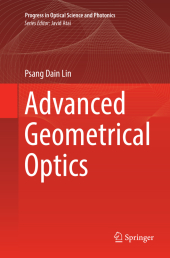 Neuerscheinungen 2018Stand: 2020-02-01 |
Schnellsuche
ISBN/Stichwort/Autor
|
Herderstraße 10
10625 Berlin
Tel.: 030 315 714 16
Fax 030 315 714 14
info@buchspektrum.de |

Psang Dain Lin
Advanced Geometrical Optics
Softcover reprint of the original 1st ed. 2017. 2018. xxiv, 460 S. 29 SW-Abb., 193 Farbabb., 200 Farbta
Verlag/Jahr: SPRINGER, BERLIN; SPRINGER SINGAPORE; SPRINGER 2018
ISBN: 9811095868 (9811095868)
Neue ISBN: 978-9811095863 (9789811095863)
Preis und Lieferzeit: Bitte klicken
This book computes the first- and second-order derivative matrices of skew ray and optical path length, while also providing an important mathematical tool for automatic optical design. This book consists of three parts. Part One reviews the basic theories of skew-ray tracing, paraxial optics and primary aberrations - essential reading that lays the foundation for the modeling work presented in the rest of this book. Part Two derives the Jacobian matrices of a ray and its optical path length. Although this issue is also addressed in other publications, they generally fail to consider all of the variables of a non-axially symmetrical system. The modeling work thus provides a more robust framework for the analysis and design of non-axially symmetrical systems such as prisms and head-up displays. Lastly, Part Three proposes a computational scheme for deriving the Hessian matrices of a ray and its optical path length, offering an effective means of determining an appropriate search direction when tuning the system variables in the system design process.
Mathematical Background.- Skew-Ray Tracing of Geometrical Optics.- Geometrical Optical Model.- Ray tracing Equations for Paraxial Optics.- Cardinal Points and Image Equations.- Ray Aberrations.- Jacobian Matrix of Ray Ri with Respect to Incoming ray Ri-1 and Boundary Variable Vector Xi.- Jacobian Matrix of Boundary Variable Vector Xi with Respect to System Variable Vector Xsys.- Prism Analysis.- Prism Design Based on Image Orientation.- Determination of Prism Reflectors to produce required image orientation.- Optically Stable Systems.- Point Spread Function, Caustic Surfaces and Modulation Transfer Function.- Optical Path Length and Its Jacobian Matrix.- Wavefront Aberration and Wavefront Shape.- Hessian Matrix of Ray Ri with Respect to Incoming ray Ri-1 and Boundary Variable Vector Xi.- Hessian Matrix of Boundary Variable Vector Xi with Respect to System Variable Vector Xsys.- Hessian Matrix of Optical Path Length.
"Professor Lin has greatly expanded the breadth and scope of using matrix representation in geometrical optics. ... Advanced Geometrical Optics could be used in teaching graduate and advanced-undergraduate students and is enthusiastically recommended for those interested in geometrical optics, optical design, and optimization." (R. Barry Johnson, Contemporary Physics, Vol. 58 (3), April, 2017)
"This book is concerned with the study of geometrical optics using a matrix method. ... Since the author intends to make this book a useful reference for geometrical optics courses oriented to graduate and senior undergraduate students, many illustrative examples are presented. Overall, this is an interesting book modernizing the classical subject of geometrical optics." (Jichun Li, zbMATH, Vol. 1366.78001, 2017)
Dr. PD Lin is a distinguished Professor of Mechanical Engineering Department at National Cheng Kung University, Taiwan, where he has been since 1989. He earned his BS and MS from that university in 1979 and 1984, respectively. He received his Ph.D. in Mechanical Engineering from Northwestern University, USA, in 1989. He has served as an associate editor of Journal of the Chinese Society of Mechanical Engineers since 2000. He has published over 80 papers and supervised over 60 MS and 11 Ph.D. students. His research interests include geometrical optics and error analysis in multi-axis machines. In geometrical optics, he employs homogeneous coordinate notation to compute the first- and second-order derivative matrices of various optical quantities. It is one of the important mathematical tools for automatic optical design.


